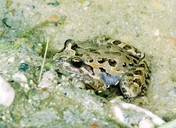|
Description
As the common name implies, these frogs can have colorful markings. There are
three pattern variations in this species: almost uniformly colored animals;
animals with large dark spots with bright edges and animals with two dark
brown longitudinal bands, one bright band along the back and two bright bands
along the sides. The belly is whitish.
The body is stout with a flat head that is wider than it is long.
The dorsal glands are arranged in longitudinal patterns along the back, or
can be absent.
The pupil is shaped like an upside-down droplet
(Noellert and Noellert 1992).
Distribution and Habitat
Country distribution from AmphibiaWeb's database: Algeria, France, Italy, Malta, Morocco, Spain, Tunisia
Of this species, three subspecies are found in Europe. D. pictus pictus
is restricted to the islands of Malta, Gozo (Ghawdax) and Sicily, where it is
found at altitudes up to 1500m.
D. pictus scovazzi has been introduced from Morocco, and has established
stable populations around the Pyrennees Orientales. Their distribution ranges
from Narbonne (F) in the north to the region of Cataluña (E) in the south
(Pleguezuelos 1997). In this area, D. pictus scovazzi occurs
from sea level up to an elevation of 500m, although it is usually found below
100m. D. pictus scovazzi is found near water in open landscapes. It
is found in orchards and vineyards, as well as on campsites. They are also
known to live and breed in slightly brackish water
(Noellert and Noellert 1992).
D. pictus auritus is also a subspecies of North African origin.
In Europe, it is found in Spain, in the province of Gerona.
In North Africa D. pictus is found in Mediterranean parts and humid
mountain regions of the Maghreb (Morocco, Algeria and Tunisia).
D. pictus scovazzi Inhabits Morocco, and D. pictus auritus
inhabits Algeria and Tunisia (Garcia-Paris and Jockusch 1999).
Their habitat consists of brooklets, irrigation ditches and cattle tracks
filled with water. On land, they hide in self-dug flat cavities under stones
(Schleich et al 1996).
Life History, Abundance, Activity, and Special Behaviors
In the Moroccan subspecies, sexual maturity is attained in one year. Mating in
North Morocco takes place from January to early November. Copulation, in which
the male clasps the female in the lumbar region lasts about 2 hr. Copulation
in the Spanish specimens lasts only 35 s to 2 min. Females lay a total of
500 to 1000 eggs in one night of copulation. The females copulate with
various males and each copulation a small clump of about 20 to 50 eggs are
laid. The ovum diameter is usually 1-1.5mm; the gelatinous envelope 3-7mm.
The eggs have no common envelope and form a loose mass on the water surface
or may sink to the bottom. Eggs usually hatch in 2-6 days. Upon hatching,
tadpoles are about 3mm in length. In 1-3 months, they grow to about 33mm
and metamorphose into froglets of 10mm (Schleich et al 1996).
Trends and Threats
In Sicily, many populations are associated with man-made water bodies such as
stone-sided cisterns, irrigation pipes and canals in cultivated areas. They
appear to be endangered by the decline of traditional methods of agriculture.
However, populations that live along rivers, seasonal ponds and swamps seem
to be less endangered. Populations ofD. pictus pictus on Malta and
Gozo are said to be threatened by a reduction of the ground-water levels
(Gasc 1997).
In order to be able to effectively protect this species, more data is needed
about its ecology and biology
Relation to Humans
D. pictus seems to be associated with man-made water bodies, at
least for part of its distribution.
Possible reasons for amphibian decline Intensified agriculture or grazing
Drainage of habitat
References
Garcia-Paris, M., and Jockusch, E. L. (1999). ''A mitochondrial DNA perspective on the evolution of Iberian Discoglossus (Amphibia: Anura).'' Journal of Zoology, (248), 209-218.
Gasc, J.-P. (1997). Atlas of Amphibians and Reptiles in Europe. Societas Europaea Herpetologica, Bonn, Germany.
Nöllert, A. and Nöllert, C. (1992). Die Amphibien Europas. Franckh-Kosmos Verlags-GmbH and Company, Stuttgart.
Pleguezuelos, J. M. (1997). Distribucion y Biogeografia de los Anfibios y Reptiles en España y Portugal. Asociacion Herpetologica Española, Las Palmas de Gran Canarias.
Schleich, H. H., Kastle, W., and Kabisch, K. (1996). Amphibians and Reptiles of North Africa. Koeltz Scientific Publishers, Koenigstein.
Originally submitted by: Arie van der Meijden (first posted 1999-09-07)
Edited by: Vance T. Vredenburg (2021-01-26)Species Account Citation: AmphibiaWeb 2021 Discoglossus pictus: Painted frog <https://amphibiaweb.org/species/1527> University of California, Berkeley, CA, USA. Accessed May 2, 2025.
Feedback or comments about this page.
Citation: AmphibiaWeb. 2025. <https://amphibiaweb.org> University of California, Berkeley, CA, USA. Accessed 2 May 2025.
AmphibiaWeb's policy on data use.
| 



 Map of Life
Map of Life